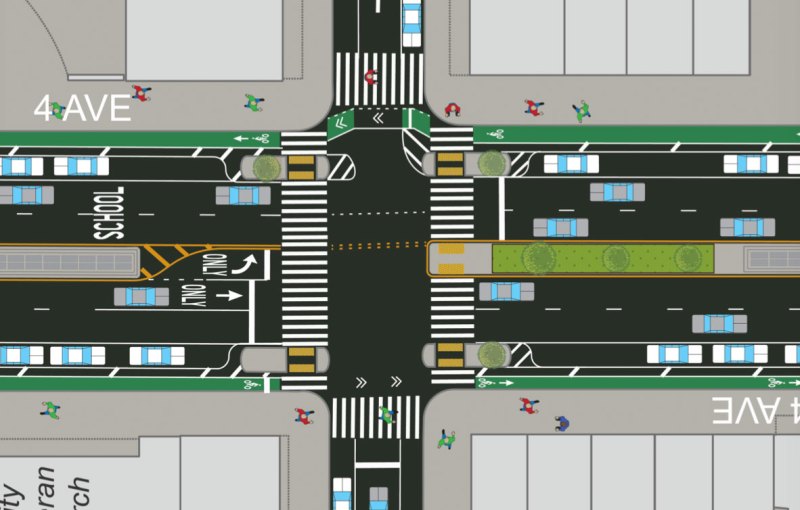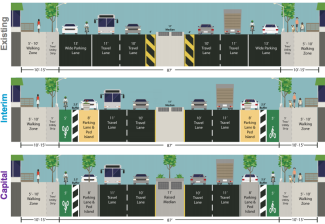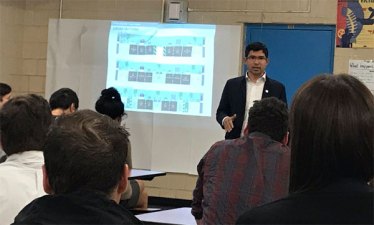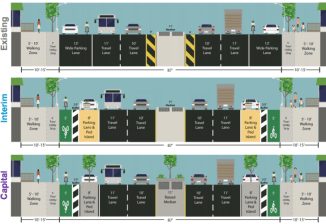DOT Shows Its Plan to Get the Reconstruction of Fourth Avenue Right
It's the only route that makes sense for protected bike lanes linking Bay Ridge, Sunset Park, and Park Slope.

Five years ago, Fourth Avenue was a six-lane speedway through the neighborhoods of western Brooklyn. At the time, says Council Member Brad Lander, most people thought adding a protected bike lane was “not even conceivable.” But since DOT implemented a road diet in 2012, removing a lane in each direction, crashes have fallen substantially, the traffic is not quite so threatening, and perceptions have shifted.
Now the city is preparing for a top-to-bottom reconstruction of Fourth Avenue, and with the urging of Council Member Carlos Menchaca, DOT has revised its initial design for the project to include curbside protected bike lanes.
Last night, DOT presented the concept for the first time [PDF], getting feedback from about 80 people at a workshop at St. Thomas Aquinas Church on 9th Street. A second workshop is scheduled for next week in Sunset Park.
Fourth Avenue is far and away the most viable potential bike route linking Bay Ridge, Sunset Park, and Park Slope, but it’s still scary to ride on, with no designated space for cycling. DOT Bicycle Program Director Ted Wright said last night that the agency wants to “make sure we get it right.” At 4.5 miles long, a protected bike lane would make the reconstructed Fourth Avenue one of the most important two-way streets for bicycle travel in the city, connecting dense residential neighborhoods to jobs and schools.
“I’m appreciative that DOT said, ‘We’re willing to take another look,'” Lander told the crowd. “I’m supportive of the design change.” So were most of the people who showed up last night.
Liz Turrigiano rides with her 8-year-old daughter on a long-tail bike from their home on the northern edge of Bay Ridge to work and school in Gowanus. She won’t bike on Fourth Avenue today, but a protected bike lane “would be a life-changer for us,” she said.

Instead of the extra-wide medians in the initial Fourth Avenue design, the new plan calls for bike lanes along the curb protected from moving traffic by parked cars. At a typical intersection, all four corners would get planted concrete pedestrian islands, shortening crossing distances and improving visibility compared to the initial design.
A Park Slope resident who gave his name as Max said the safer crossings can’t come soon enough. “The sooner you can get the pedestrian islands in, then you decrease the blood pressure and don’t have to rush across like it’s a freeway.”
A few other points from Wright’s presentation stand out.
- The motor vehicle traffic configuration — moving lanes, turn lanes, turn bans, and signals — will remain essentially unchanged. That means a northbound morning rush-hour moving lane between 38th Street and the Prospect Expressway will stay in place, limiting the physical protection and use of pedestrian islands on about a mile of the eastern side of the street. DOT may use plastic posts to separate the bike lane from car traffic on this stretch.
- The design is in flux on the northern blocks of the project area approaching Atlantic and Flatbush, where northbound Fourth Avenue still has three travel lanes. A recurring theme sounded by participants last night was the desire for the northbound bike lane to continue past Carroll Street.
- DOT showed an intersection treatment with the stop bar for bicyclists placed past the crosswalk, where people on bikes would be more visible to waiting drivers about to turn right — reminiscent of Dutch intersection design though without the full feature set of protected intersections.
The construction timetable is hazy, but a 2017 groundbreaking seems unlikely. DOT will be refining its design based on feedback from the workshops, then presenting the project to the community boards along the route.
Next week’s workshop in Sunset Park takes place at PS 136 on Thursday, May 11, at 6:30 p.m.




